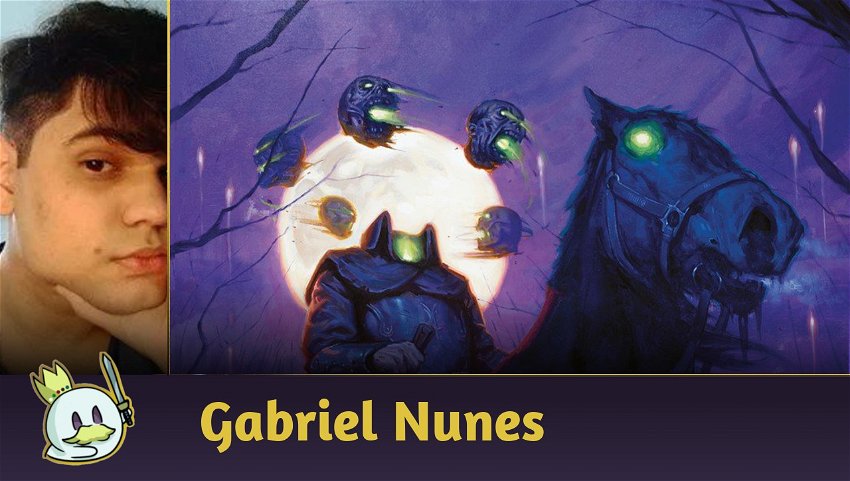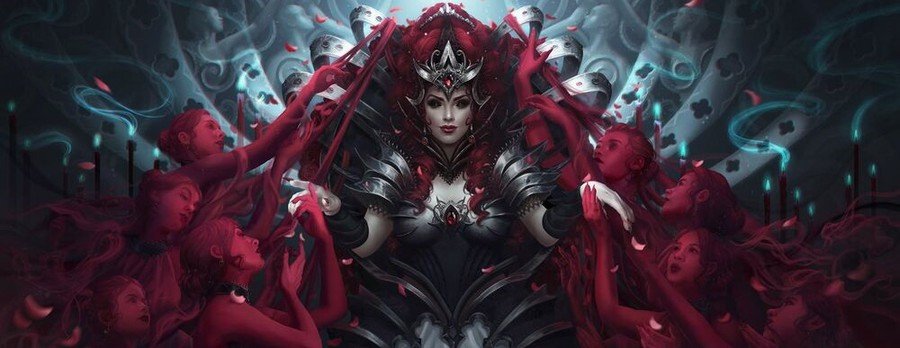Innistrad: Crimson Vow has just arrived, and as with every set that has just come out, of course we are always looking for cards that can support or create a new strategy for our favorite format.
As for Innistrad, it is impossible not to think about the tribes present in the plane. "Are any humans worth to play in Humans?", "Maybe some vampire brew is finally playable" and "Are any of the new spirits going to make my Bant Spirits come back to the Metagame?" these are thoughts that ran through everyone's minds during the spoiler season, but in the end, one specific support caught my eye and showed some potential: Innistrad's new Zombies, more specifically for the Zombies Bombardment strategy!
The Sacrifice Mechanic
Zombies Bombardment is a deck that exists in Legacy based on sacrifice and return creatures, where its main core consists of returning Gravecrawler from the graveyard several times and using it as a sacrifice fodder for the deck's effects, such as Carrion Feeder and, of course, for Goblin Bombardment.
Reading this description, it's clear that we're reminded of decks like Jund Food, which was quite impressive in Standard, or even BG Yawgmoth (which we've even talked about in an article). But the main difference that zombies have, especially after the supports that came in these last two sets, is the potential for aggressiveness. To demonstrate this, I've put together some lists of what I think we can do with the deck, and that's what we're going to talk about now!
Rakdos Zombies
And here we have a clear example of what exactly we want to do.
This list is totally focused on the interaction between creatures, we have constant sacrifice sources, creatures that return from the graveyard, and creatures that benefit from Zombies entering the battlefield or dying, so I think it's perfect to use this version for a full analysis of the deck's objective.

As for sacrifice sources, we have the aforementioned Carrion Feeder and Goblin Bombardment.
Feeder is one of the highest impact creatures in the deck, being able to grow steadily with each loop with Gravecrawler and becoming increasingly difficult to block. Its flaw is that it is fragile to removals, especially in the early game, in addition to not being able to block, but the fact that it is a one mana creature that pulls removals from opponents already shows the importance and strength that this creature has.
Goblin Bombardment earns its space by always being a good sac outlet, which can serve as removal or mainly to close the game with direct damage. The enchantment makes you always get some value from your creatures, being a great resource in longer matchups and a good board control when the opponent is the beatdown.
An important point for both of these cards is that they provide a huge advantage against exile removals, such as Path to Exile and Prismatic Ending, cards that would normally be problematic against our graveyard-based deck.

But sac outlets are only useful when allied with creatures that want to be sacrificed. For this, the tribe has extremely functional creatures.
Let's start with the most important: Gravecrawler is the main and most advantageous gear for any sacrifice deck interaction. Its payback condition is simple, and it has a low-cost, which makes its synergies work practically like a "mana sink", making every extra black mana a resource for your Sac Outlets.
Jadar, Ghoulcaller of Nephalia is a recent support that solidifies the strategy, generating bodies that alone would put a good pressure on the opponent. Here, we can explore its potential even more, using its zombies as a sacrifice fodder for our effects. It's slower than Gravecrawler as it practically generates one token per turn, but it's still a constant resource, helping us on early and late game.
Dreadhorde Butcher is one of the most strategic creatures to be sacrificed, as you will usually only sacrifice it once, but if all goes well it will deal some damage, making it perfect for ending games or removing important creatures, in addition to naturally being a growing threat. Playing a Butcher on turn two and getting it connected will likely make your opponent itch to try and remove it as soon as possible.

To complete our synergy, we have powerful payoffs, cards that will benefit from our synergies in some way. One example of this is Champion of the Perished, which becomes an increasing threat whenever a zombie enters the battlefield, and since virtually everything we do results in zombies entering and leaving the battlefield, it's not uncommon for it to get too big too fast.
Undead Augur is the only zombie in the deck that provides card draws (and he draws many cards), in addition to bringing a natural advantage against removals, replacing itself with a card if he dies. Augur is a Card Advantage machine, its flaw is causing you a lot of damage in the process, but as we're talking about a very aggressive deck, it's generally worth it.
Speaking of advantages against removals, it's time to talk about the card that made me write this article. Headless Rider is a zombie that just arrived in Innistrad: Crimson Vow and fits perfectly in this deck.
Creating new zombies whenever your creatures die, the simple fact that the Rider is on the field makes the opponent's removals far less advantageous. But when we think that all our loops create 2/2 bodies is what the card's potential really is: I see this creature with great potential, and maybe it's the missing support for zombies to have their place on the moon.
As we could see, the synergy between the pieces of the deck fits together quickly, generating plenty of offensive potential, combined with a very low curve and a mana sink system that will greatly optimize our curve and sequencing.
Mardu Zombies
Of course, when we think of low-curve decks that use the graveyard, Lurrus of the Dream-Den stands out in our minds. In this snippet of the article, we're going to take a look at what are the advantages and disadvantages of using both the famous kitten and the third color in the deck.

Thinking about adding the white color, two cards are highlighted to the deck.
Wayward Servant is very useful for the strategy, being a good payoff that will unbalance the game in your favor, whereas the Tidehollow Sculler is a great interaction option, especially when we have Lurrus and one of our sacrifice resources because taking Sculler off the battlefield before his first effect resolves, the second effect is "countered", so you can take your opponent's cards without you worry about a possible return from them.
Another advantage is to run Mishra's Bauble, which is perfect in conjunction with the Cat, creating a very interesting card advantage. Let's face it, Lurrus of the Dream-Den can really exploit its potential here, as we're constantly sending our cards to the graveyard.
It is also important to talk about the benefits of bringing white to the sideboard, as it is one of the best colors for the reserve. White has permanents that can confuse the opponents a lot, in addition to dealing better with opponents' interactions, as it has more artifact or enchantment removals.
As for the disadvantages, I think we have two very relevant ones, the first one being related to the mana base. As I said up there, the deck always has use for black mana because of Gravecrawler, so adding new colors and other lands that can't cast it might be problematic at crucial moments in the game.
Now, the main drawback here is about using Lurrus, as you need to play only with permanents with mana value 2 or less. As said earlier, the Headless Rider is, in my opinion, one of the most important supports that can leverage the deck, and leaving it out seems to be quite harmful, and I think it can greatly reduce the deck's reach.
Honorable Mentions
When making a list, several interesting cards go through your head or are suggested, but end up not being in the final deck. I thought it was important to talk a little about some of these cards, also because they are also possibilities for future constructions.

Cryptbreaker is a great one-drop, and brings great advantages with Headless Rider, which will create more board for you to draw more cards. His problem is the low the offensive potential, as his ability to generate zombies is quite slow, and he doesn't have the best body in the game. Also, we have Undead Augur, which even costs an extra mana, draws more cards and has a stronger body.

Plague Belcher is one of the biggest creatures possible for the deck, even with the drawback of decreasing/killing one of your creatures, 5/4 is a very interesting offensive body, and the static ability of this zombie is fascinating for the deck's purposes, which with loops of returning creatures to the graveyard will deal additional damage. The problem is that the three-drop slots of this deck are practically at its limit, and Headless Rider turns out to be better than this card at all.

Splashing green was one of the first things I thought of when I researched the deck; Grist, the Hunger Tide is great when you think of all our synergies with graveyard and sacrifice, and Collected Company is perfect for digging up specific creatures and putting them directly onto the battlefield when your opponent least expects it.
But aside from the mana base issue, the deck's curve is too short for Company to be worth it.
Playing Company and putting two one-mana creatures seems like a pretty bad way to use the card to me, and with twelve or sixteen creatures on that curve, I'm afraid this scenario isn't so improbable.
Conclusion
Building lists is a difficult task and judging if they are good enough for the Metagame is even harder, but with a great offensive potential, low curve and well-constructed interactions, Zombies Bombardment appears to have what it takes to be an interesting tribal for Modern. I will definitely love to test the Headless Rider on the list as soon as possible, and I will bring the results to you.
That's all for today.
Thanks for reading!














— Comments 0
, Reactions 1
Be the first to comment